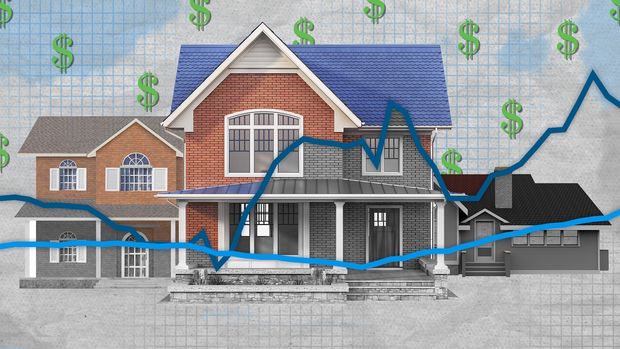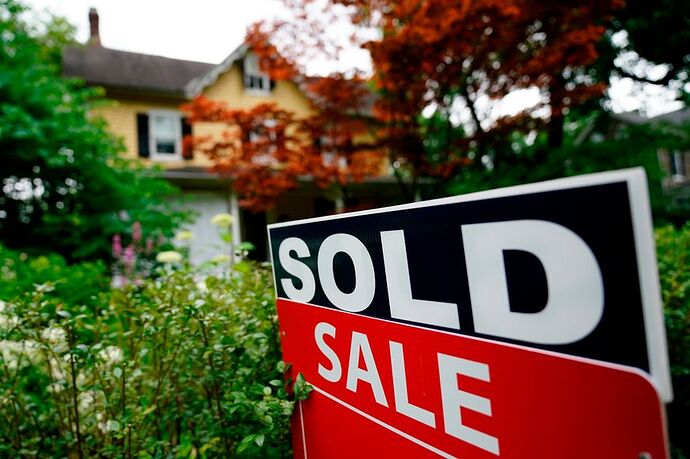U.S. Home Sales Drop for Eighth Straight Month in September
Slowdown in the market is expected to continue as mortgage rates approach 7%, up from about 3% a year earlier
Sales of previously owned homes declined 1.5% in September from the prior month.PHOTO: MATT ROURKE/ASSOCIATED PRESS
WSJ
Updated Oct. 20, 2022
U.S. existing home sales fell for an eighth straight month in September, the longest streak of declines in 15 years, as the once-booming housing market becomes a bigger drag on the U.S. economy.
Sales of previously owned homes declined 1.5% in September from the prior month to a seasonally adjusted annual rate of 4.71 million, the weakest rate since May 2020, the National Association of Realtors said Thursday.
Excluding the early months of the Covid-19 pandemic, September’s existing-home sales rate was the lowest since 2012, when the housing market was just beginning to recover from the subprime crisis.
The market’s abrupt slowdown since the start of the year is a direct response to rising mortgage rates, which reached 6.94% this week. That has made most home purchases less affordable and is scaring away buyers.
It also reflects one of the biggest impacts so far of the Federal Reserve’s effort to fight high inflation by raising interest rates to slow economic growth.
Cooling off the red-hot market is a key part of the Fed’s process because home sales are highly interest-rate sensitive and fuel related economic activity.
A weaker housing market dampens demand for many other goods and services. Prices and sales of furniture and appliances fell in September, while spending on lumber and plumbing fixtures declined as well. New-home construction has declined in response to lower demand.
“The housing market has entered a recession before the overall economy does,” said Nancy Vanden Houten, lead U.S. economist at Oxford Economics. “We look for housing to be a drag on growth, really, for the next several quarters.”
The Fed’s rate increases have fueled higher mortgage rates. The average rate on a 30-year fixed-rate mortgage is the highest level in two decades, housing-finance agency Freddie Mac said Thursday.
Some buyers no longer qualify for mortgages at current rates, while others have stepped back from the market due to broader uncertainty about the economy, real-estate agents say. Many current homeowners have mortgage rates below 4%, and some prospective sellers are opting to stay put rather than sell their homes and buy new ones with higher borrowing costs.
Demand is likely to continue to slow in the coming months, as the Fed has signaled its intention to keep raising rates and as home purchases typically slow in the fall and winter. Mortgage applications for home purchases fell 38% from a year earlier in the week ended Oct. 14, according to the Mortgage Bankers Association.
Why Housing Can Skew Inflation Numbers
YOU MAY ALSO LIKE

Why Housing Can Skew Inflation NumbersPlay video: Why Housing Can Skew Inflation Numbers
Housing is one of the most weighted categories when tracking inflation, but it’s also one of the most complicated to measure. WSJ’s David Harrison explains how the shelter index is calculated, and why it can muddy the inflation outlook for the Fed. Illustration: Laura Kammermann
Homes typically go under contract a month or two before the contract closes, so the September data largely reflect purchase decisions made in August and July, when interest rates were slightly lower than they are today.
“People have been so used to seeing the 30-year fixed between 3% to 4%,” said Joel Kan, deputy chief economist for the MBA. “[Interest rates nearing] 7% is both a huge tangible shock but also likely a mental or psychological barrier too.”
The new-home market, which accounts for about 10% of total home sales, is also showing signs of weakness. Housing starts, a measure of U.S. home-building, fell 8.1% in September from August, the Commerce Department said this week. A measure of U.S. home-builder confidence fell for the 10th straight month in October to the lowest level since May 2020, the National Association of Home Builders said this week.
Despite the sharp decline in sales, home prices are rising on a year-over-year basis, in part because supply remains tight. But price growth is slowing from its red-hot pace earlier in the year. The median existing-home price rose 8.4% in September from a year earlier to $384,800, the third straight month of single-digit-percentage increases following 23 months of double-digit-percentage annual price growth, according to NAR. Some economists expect prices to post year-over-year declines starting next year.
Prices fell month-over-month for the third straight month after reaching a record high of $413,800 in June, NAR said.

Roman and Sondra Solene PHOTO: ROMAN SOLENE
Roman and Sondra Solene listed their Phoenix home in August because they wanted to move into a smaller house. But after seven weeks, they hadn’t received any offers and interest rates were climbing, making them reluctant to give up their current 2.85% rate, Mr. Solene said.
“I thought, ‘Even if we downsize, my mortgage is going to be pretty close to what we’re currently paying,’” he said. “Once [the average rate] started going into 6.3%, 6.4% territory, I was like, ‘It’s just not worth it.’”
They took the house off the market and decided to stay put.
Advertisement - Scroll to Continue
In the four weeks ended Oct. 9, 7.9% of homes on the market each week had a price drop, up from 4% a year earlier, according to real-estate brokerage Redfin Corp.
“Mortgage rates are high, and that’s stretching affordability,” said Sam Hall, property economist at Capital Economics. Capital Economics is forecasting home prices to fall year-over-year starting in March, as measured by the S&P CoreLogic Case-Shiller National Home Price Index.
The slowdown in sales and price growth is likely to be most significant in the highest-priced markets, said Lawrence Yun, NAR’s chief economist. Home-sale prices fell 3% from a year earlier in Oakland, Calif., in the four weeks ended Oct. 9, while they fell 2% year-over-year in San Francisco, according to Redfin.
The California Association of Realtors forecast last week that the state’s median home-sale price would decline 8.8% in 2023 to $758,600.
Median home-sale prices in Idaho’s Ada County, which includes Boise, rose 0.9% in September from a year earlier, according to the Boise Regional Realtors. That is down from 44% year-over-year price growth in May 2021.

Lilly Kritler and fiancé Jackson Waste PHOTO: LILLY KRITLER
Jackson Waste, 26 years old, was nervous about house hunting in Boise, because he had heard from co-workers how grueling the process was. But when he and his fiancée, Lilly Kritler, started shopping in August, they found little competition. The couple bought a three-bedroom house in September for $395,000, about $10,000 below the asking price.
“I was ratcheting up for disappointment after disappointment,” Mr. Waste said. But “it’s like a light switch got flipped” in the market, he said.
News Corp, owner of The Wall Street Journal, also operates Realtor.com under license from NAR.
Corrections & Amplifications
The average rate on a 30-year fixed-rate mortgage was 6.94% this week, according to mortgage-finance giant Freddie Mac. An earlier version of this article incorrectly said it was 6.92%. (Corrected Oct. 20)
